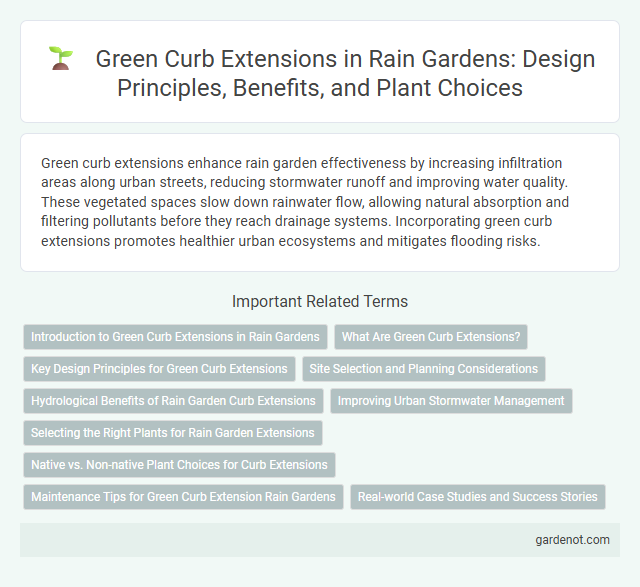Green curb extensions enhance rain garden effectiveness by increasing infiltration areas along urban streets, reducing stormwater runoff and improving water quality. These vegetated spaces slow down rainwater flow, allowing natural absorption and filtering pollutants before they reach drainage systems. Incorporating green curb extensions promotes healthier urban ecosystems and mitigates flooding risks.
Introduction to Green Curb Extensions in Rain Gardens
Green curb extensions are innovative rain garden features designed to capture and manage stormwater runoff from urban streetscapes. These structures expand the sidewalk or curb edge, allowing increased infiltration and filtering of pollutants through planted vegetation and engineered soils. By reducing surface water flow and improving water quality, green curb extensions enhance urban resilience and promote sustainable stormwater management.
What Are Green Curb Extensions?
Green curb extensions are roadside design features that expand the sidewalk area into the parking lane, incorporating vegetated rain gardens. These extensions improve stormwater management by capturing and filtering runoff from streets, reducing pollutants before they enter sewer systems. Enhancing pedestrian safety and neighborhood aesthetics, green curb extensions support urban sustainability and biodiversity.
Key Design Principles for Green Curb Extensions
Green curb extensions optimize stormwater management by incorporating permeable surfaces and native plantings to enhance infiltration and pollutant removal. Designing with appropriate soil media depth and ensuring proper runoff flow promotes effective water retention and supports healthy vegetation growth. Strategic placement near street edges and pedestrian pathways maximizes environmental benefits while improving urban aesthetics and safety.
Site Selection and Planning Considerations
Green curb extensions require careful site selection to maximize stormwater capture and reduce urban runoff effectively. Prioritize locations with adequate sunlight, suitable soil permeability, and proximity to downspouts or impervious surfaces for optimal infiltration. Planning must also account for pedestrian traffic patterns and existing underground utilities to ensure functionality and safety.
Hydrological Benefits of Rain Garden Curb Extensions
Green curb extensions integrate rain gardens to enhance urban stormwater management by capturing and filtering runoff directly at the source. These structures increase infiltration, reduce surface water volume, and mitigate pollutants before they enter drainage systems, effectively improving water quality. By promoting groundwater recharge and decreasing peak flow rates, rain garden curb extensions support sustainable urban hydrology.
Improving Urban Stormwater Management
Green curb extensions enhance urban stormwater management by intercepting runoff at street edges, reducing pollutant loads entering waterways. These landscape features increase infiltration and promote groundwater recharge, mitigating flooding risks in densely paved areas. Integrating green curb extensions with rain gardens supports sustainable urban drainage systems and improves overall water quality.
Selecting the Right Plants for Rain Garden Extensions
Selecting the right plants for green curb extensions in rain gardens is essential for maximizing stormwater infiltration and pollutant removal. Native species with deep root systems, such as Switchgrass (Panicum virgatum) and Blue Flag Iris (Iris versicolor), improve soil permeability and provide habitat benefits. Choosing drought-tolerant and flood-resistant plants ensures resilience during variable weather conditions, enhancing the long-term performance of rain garden extensions.
Native vs. Non-native Plant Choices for Curb Extensions
Native plant choices for green curb extensions enhance stormwater absorption, support local biodiversity, and reduce maintenance needs due to their adaptation to regional climate and soil conditions. Non-native plants may offer aesthetic variety but often require more water, fertilizers, and pest control, potentially disrupting local ecosystems within rain gardens. Selecting native species such as switchgrass, coneflowers, and sedges optimizes curb extension functionality by improving water filtration and providing habitat for pollinators.
Maintenance Tips for Green Curb Extension Rain Gardens
Regularly inspect green curb extension rain gardens to remove debris and prevent clogging of drainage areas, ensuring efficient water infiltration. Prune native plants to maintain optimal growth and replace any invasive species that may threaten the garden's health. Mulch the soil surface annually with organic material to retain moisture, suppress weeds, and enhance microbial activity optimizing pollutant filtration.
Real-world Case Studies and Success Stories
Green curb extensions have demonstrated significant positive impacts on urban stormwater management, as evidenced by case studies in Portland and Seattle where runoff volume decreased by up to 40%. These installations enhance rain garden efficiency by increasing infiltration and reducing pollutants entering waterways, leading to improved water quality in surrounding ecosystems. Success stories highlight not only environmental benefits but also community engagement and increased pedestrian safety in neighborhoods implementing green curb extensions.
Green curb extension Infographic

 gardenot.com
gardenot.com